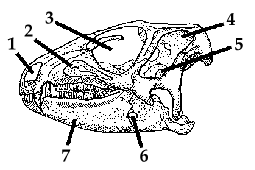



Archosauria: More on Morphology
The archosaurs are characterized by numerous synapomorphies that lend strong support to the hypothesis that they form a monophyletic group (clade) exclusive of other Reptilia. First of all, the "stem archosaurs" (properly termed Archosauromorpha), including Champsosauridae and Euparkeria, have a calcaneal tuber. This is a bony process projecting posteriorly from the ankle joint that serves as an attachment point for some of the lower leg flexor muscles. If you feel your heel, the bone that forms it is your calcaneal tuber. This is an example of convergent evolution; synapsids and archosaurs evolved these features independently.
 Archosaur skull: The archosaur skull includes two new fenestra (skull openings). The first of these is the mandibular fenestra (6), an opening through the jawbone. The other is the antorbital fenestra (2), a term that means "in front of the opening for the eye." |
Later archosauromorphs, like Euparkeria and the true archosaurs, evolved several key diagnostic features. The picture at right shows the two new skull openings, the mandibular fenestra and the antorbital fenestra, that appeared in archosauromorphs close to the Archosauria. Another new feature that appeared around this point was the presence of serrated (saw-edged) teeth set in sockets (a condition called thecodonty). Also, a large process on the shaft of the femur, the fourth trochanter, served as the attachment point for major tail muscles, the caudofemoralis group of thigh retracting muscles. Finally, ancestral archosaurs had a double row of bony plates (called scutes, or osteoderms) running along the backbone.
True archosaurs (the Archosauria proper), including the major stem groups Pseudosuchia (the crocodilians and their relatives) and the Ornithosuchia (the birds and their relatives) evolved yet more new features. The fifth toe in the foot, homologous with your "pinky toe" was reduced in size. In earlier vertebrates, the palate (roof of the mouth) bore at least one row of accessory teeth, but the archosaurs appear to have lost this feature, as did many other lineages of tetrapods. Finally, the two main lineages of archosaurs each have a specialized ankle joint that changed differently in each group, as shown below.
 Archosaur ankles: The two major groups of archosaurs are distinguished by differences in the joint of their ankle. The crocodiles and their relatives (Pseudosuchia) have a crurotarsal ankle joint (above at left), while dinosaurs and pterosaurs (Ornithosuchia) have a mesotarsal ankle joint (above at right). The red line in each image shows the plane of the ankle hinge. (T=tibia, F=fibula, A=astragalus, C=calcaneum) |
The Pseudosuchia have what is called a crurotarsal, or "crocodile-normal" ankle. This is a very flexible arrangement in which the astragalus (medial proximal ankle bone) bears a peg that fits into a socket in the calcaneum (lateral proximal ankle bone). Ankle rotation then occurs between these two bones, permitting both a somewhat erect stance (like the crocodilian "high walk") where the hindlimb is held closer to the midline of the body, and a more sprawling stance like that of earlier tetrapods. The result of this is that the pseudosuchians can move in two different ways; walking with an erect or sprawling posture.
The Ornithosuchia have a mesotarsal ankle, which is a simple hinge joint between the lower leg and astragalus and calcaneum, and the distal ankle bones. This restricts the posture to a more erect orientation, so the gait can be called parasagittal — the limbs move parallel to the vertebral column, and are held relatively vertical. Birds and most mammals have this parasagittal gait; birds inherited it from their dinosaurian ancestors, while mammals evolved it independently. The advantage of a parasagittal gait might be that it improves maneuverability/agility. A concordant disadvantage would be that it reduces stability. It's easier to tip over an erect cow than it is to tip over a more sprawling crocodile of similar size; the crocodile has a wider base of support, and thus can be said to be more stable. However, the relationship between stance and stability is still not completely understood, so it's difficult to say exactly what advantages an erect stance has. Another proposed advantage of an erect stance and parasagittal gait was that it was more efficient, but this has not held up to experimental analysis — erect animals move about as efficiently as similarly-sized sprawling ones.
It is difficult to say what sorts of soft tissues extinct archosaurs really had, but the fact that both crocodilians and birds have a four-chambered heart lends support to the notion that this is a trait inherited from a common ancestor (and another convergence with mammals). Birds and crocodiles also share expanded pneumatic sinuses in their skulls — and elsewhere in bird skeletons — which can also be seen in fossil archosaurs, such as the hadrosaurs, so the expansion of these craniofacial air sinuses is another trait shared by archosaurs. The sinuses appear to serve as skull-remodeling agents, reshaping the bones of the skull in response to stresses and other influences.